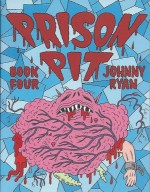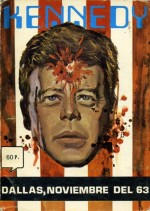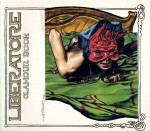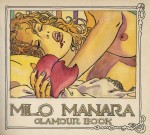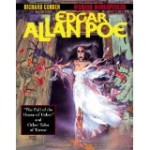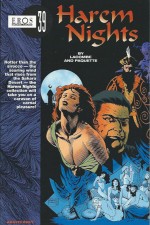
By Michel Lacombe & Yanick Paquette (Eros Comics/Fantagraphics Books)
ISBN: 978-1-56097-354-6
This book contains stories and images of an extremely adult nature, specifically designed for the consumption of consenting adults. If reading about such things is likely to offend you, please stop now and go away. Why not come back tomorrow when I’ll uncover something different that will probably offend somebody else.
I’ll let you in on a little secret: if you do it right – and I know some people try really, really hard – sex is supposed to be fun.
Now we all know that in the real world nobody’s actually any good at nookie and there’s always someone trying to put a stop to it (hopefully not your own consenting, actively participating partner-of-choice) but fun-filled fictional fornication has usually sought to be a jolly, joyous affair – which is why so much pornography aspires to low comedy.
When esteemed champion of graphic diversity Fantagraphics jumped on the harmless smut bandwagon that proliferated in the American comics industry at the very end of the 1980s with their Eros Comics imprint, they initially gathered the most stylish of European and foreign adult material (such as Solano Lopez & Barreiro’s Young Witches – which is simply considered mere mature reading on the hang-up-free Continent) to complement quality home-grown creators such as Gilbert Hernandez, Bill Willingham and Ho Che Anderson (with Birdland, Ironwood and I Want to be Your Dog, respectively).
In such a creatively welcoming environment, might not such adults-only projects also attract horny young neophytes and talented newcomers with something fresh to say on the old-in-and-out?
One of the company’s all-new 4-issue miniseries for men – or at least folk with convincing fake IDs – was crafted by a couple of eager-beaver Canadians named Michel Lacombe & Yanick Paquette and offered a different twist on a positively ancient scenario beloved of lovers and romantics everywhere…
Following a wry comic strip introduction from pioneering cartoonist Jacques Boivin, the even-harder-after-midnight action begins in the ancient Middle Eastern city of Avalhad where unpopular but chosen-by-God Sultan Arful Al Hussaj lived a life of grotesquely hedonistic, shame-free excess. Although he was the most repulsive and stupid of men, his servants were devoted to his service and the many glorious women of his seraglio hungered for his attention.
That wasn’t surprising at all, for so ugly was Hussaj that the Court Wizard Ziebnad had placed a spell on all the nubile concubines. From sunset to sunrise all the harem girls were possessed by an insatiable hunger for man’s love: a fire that cruelly drove them all wild, long after the Sultan had made his nightly selection.
Those left unattended each evening writhed in desperate, agonising frustration, boiling with an unquenchable heat until the sun rose again and could even expire of unfulfilled arousal…
Neither the magus nor Hussaj cared: after all they were only women.
Tatia was one of those thus afflicted and although most of her sister courtesans were resigned to their nightly torture, she yearned to be free of it and her unwholesome master. Unhappy even in her daylight hours of sequestered opulence and indolence, her only companion and confidante was fellow concubine Bita – who secretly yearned for the blithely oblivious Tatia even when the sun was high in the sky and unseemly passions were not artificially enflamed…
Events came to head (yes I meant to say that) when Ziebnad finally convinced his master that for the sake of the kingdom he should stop screwing around and sire an heir.
Until then most of the Sultan’s predilections had taken him in other directions and down different avenues, but with his relatives now making openly seditious moves, caution dictated that Hussaj should ensure some dynastic continuity if he wanted to keep his head and the crown.
The Sultan reluctantly acquiesced but, rather than go to the trouble of finding a suitable wife, agreed to simply impregnate and wed one of the concubines he was already familiar with.
Whoever was picked that night would do…
As narrative would have it, Tatia got the nod and was brusquely married to the Sultan to legitimise the issue before the monster began to slake his nightly passions. Perhaps it was because everything started before sunset or perhaps the vile potentate was especially unwholesome this time, but as his own inner fires overwhelmed Hussaj, Tatia somehow rebelled and in disgust killed her new husband…
Fighting the withering power of the curse, she then fled the palace before she could be discovered and hid in the city: her ensorcelled libido making her a potential toy and victim of every man from merchant to beggar…
How the runaway bride escaped her pursuers, founds faithful allies, overthrew the corrupt regime, destroyed the wizard, freed herself and her fellow accursed concubines and eventually rode into the sunset with her hard-won true-love is an engaging if slight and lasciviously predictable tale that will amuse and delight open-minder lovers of erotica everywhere.
Of course in the end all of this is just an excuse to see naked people cavorting – and yippee! for all that – but there’s also a dark tale of oppression and hard-won liberation hiding under all that glistening skin and heaving flesh that successfully approaches that Holy Grail of Porn – a strong story that successfully holds together the bits between all the bonking…
Rude but not crude, naughty and nice, this is a great example of art for smut’s sake with no pretensions and a good deal to recommend it.
© 1994, 1995, 1999 Michel Lacombe & Yanick Paquette. All rights reserved.

